-

Deb Portable Skin Cleanser Starter Pack
£118.99Supplied in: Single kit -

Deb TouchFREE Ultra Dispensers
From £53.49 To £71.49Supplied in: Single -

Hygiene Stations
£81.13Supplied in: Single kit -

Deb Cutan Complete® Foam Hand Sanitiser
From £3.99 To £15.54Supplied in: Single -
Promotion

Portable Skin Safety Cradle - Skin Sanitiser
£124.99
£117.55
Supplied in: Pack of 6 -

Deb Portable Skin Safety Cradle
£62.99Supplied in: Single -

Deb InstantFOAM® 1L Hand Sanitiser Manual Dispenser
£14.98Supplied in: Single -

DEB InstantFOAM® Hand Sanitiser Kit with FREE Dispenser
£104.54Supplied in: Single kit -
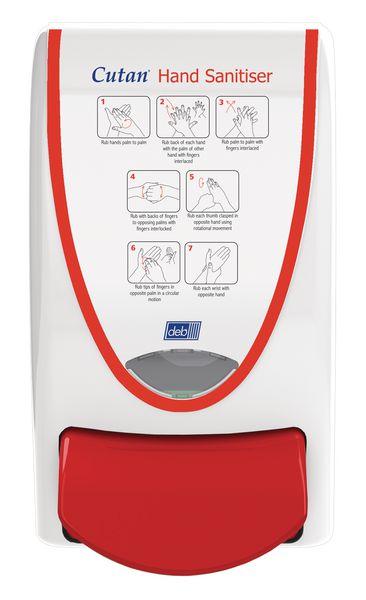
DEB 7 Circles Cutan® Sanitise Dispenser
£8.94Supplied in: Single -

Hand Gel Station Refill
£6.49Supplied in: Single
Antibacterial Hand Sanitiser Gel
Need help?
 Find out which hand gel is best for your workplace
Get Hand Sanitiser Solutions Chosen By Experts
Find out which hand gel is best for your workplace
Get Hand Sanitiser Solutions Chosen By Experts
Countless studies have proven that good hygiene helps reduce the spread of infection. The deployment of hand sanitiser, particularly in the form of antibacterial hand gel, throughout work and public places is vital to maintain strong hygiene practices. Not only does this stop viruses spreading but for employers it helps comply with health and safety legislation.
We supply an expansive range of hand sanitiser gel, liquid and foam as well as suitable dispensers and hand sanitiser stations. Create the best environment for your team indoors or out with rapid fuss-free delivery on all orders.
Also discover:
First Aid Supplies
Hand Sanitiser Gel & Dispensers - Buying Guide
For some workplaces, the use of sanitising hand gel has long been routine and required by health and safety regulations. Hospitals and doctor’s surgeries, for example, have been providing sanitising facilities for their staff, patients and visitors for years, but even in an office or other workplace, sanitiser can help keep chances of cross-infection lower.
We have a number of choices available when it comes to hand gels. Deb InstantFOAM, for example, is HACCP International Certified and is skin friendly while also providing a powerful disinfecting punch. This foaming solution with dispenser kit would be a good addition for first aid rooms, hallways, and entrance areas as it can be quickly installed to flat surfaces for easy access.
Clinell Alcohol Sanitising Hand Gel is also popular with doctors and is used by other professionals, but would be equally useful in offices and other workplaces. Its pump action makes it easy to apply, while the inclusion of natural moisturisers such as aloe vera and soothing green tea extracts mean that it can care for your hands while also killing 99.999% of germs. It was developed by doctors, so you can rest assured that, if you and your employees use this formulation, you will be reducing the spread of germs, bacteria and infections as much as possible.
Alternatively, an InstantFOAM® Hand Sanitiser Manual Dispenser would make a great addition to bathrooms or even next to doorways and exits as a means of reminding workers and visitors to keep their hands clean. These anti-bacterial foam dispensers can easily be fixed to a wall, making it convenient for people to comply with hand hygiene policies. It should be filled with InstantFOAM® Hand Sanitiser, which kills 99.999% of germs and bacteria within 15 seconds of contact. It also absorbs quickly to avoid spills, drips, splashes and unnecessary excess fluid. Why not save money and install a series of DEB InstantFOAM® Hand Sanitiser Kit with FREE Dispenser throughout your premises? This cost-saving kit includes the tools and accessories you need to get started with new hand cleansing facilities out of the box.
We all know bacteria and viruses can survive on almost any surface we touch. An electrical automatic dispenser, like the DEB TouchFree Ultra Dispensers offer a great way to eliminate the spread of infection from touching the soap dispenser.
Remember, all orders include fuss-free delivery from our UK distribution centre. For more information on how to protect everyone in your workplace, view our coronavirus guide.
FAQ
Is rubbing alcohol the same as hand sanitiser?
While they share many of the same components there are also significant differences between them. Essentially rubbing alcohol (also known as isopropanol) contains denaturants - a toxic and often foul-smelling substance.
To be more specific, isopropanol may contain any volume of methanol, methyl ethyl ketone, acetone, denatonium or a combination of these.
| Product | Kind to Skin | Added Emollients | Added Denaturants | Avg. <70% Alcohol |
|---|---|---|---|---|
| Hand Sanitiser | ||||
| Rubbing Alcohol |
Whereas specialist skincare and body cleansing products - often in gel, liquid or foam forms - are formulated to be much kinder to skin. This makes them a much safer and more comfortable to apply solution. For example the Relisan Alcohol Hand Gel contains denatured ethanol with added emollients; making this an effective hand gel that can be used at home or when you travel - ideal if water is not available.
There is a view that isopropanol can be used, in small quantities, as a temporary alternative to a specially formulated off-the-shelf spray, gel or foam. However it is important to be aware that it can cause significant damage, particularly if applied as a long-term solution.
Is hand sanitiser toxic if ingested?
In short - yes, definitely. Alcohol-based antiviral and antibac hand gel products are not designed to be consumed. There are reports of individuals who have taken such products orally and been admitted to hospital. Sadly, some of these people passed away from the toxicity while others have survived but suffered serious long-term visual impairments.
During normal exposure, such as from a manual or automatic hand dispenser, or pelican pump, you are very unlikely to be exposed to significant vapours from these skincare products.
However the high volumes of ethanol, isopropanol and/or n-propanol contained within these products may mean some users experience minor symptoms such as nausea, dizziness or headaches, if they are not used in a well-ventilated area. It is important to add that, during normal use indoors or out, the likelihood of such effects is extremely low.
Which hand sanitiser is best gel or liquid?
Essentially it comes down to personal preference. To make an informed decision it is best to consider the key differences as well as the similarities.
Gel
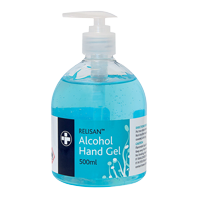
- Thicker consistency
- Requires longer contact time
- Ideal for use on the go
- Can clog dispensers
- May leave a residue
VS
Foaming Liquid
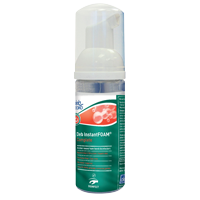
- Consistency like water
- Usually lower contact time
- May require wet hands first
- Does not dry in hard clumps
- Leaves no residue
For example a gel will often contain a greater amount of thickening agents which give it the distinctive tactile, less fluid consistency. Whereas liquid and foam hand sanitisers have a consistency closer to pure water.
Add to this, in most cases a gel product will take slightly longer to dry than a liquid foam equivalent. Similarly a liquid solution usually requires a shorter contact time when compared to some gel products.
However, for the most part, gel solutions do not require the hands to be wet before use; like many foaming liquid products. In addition to this; a study published in 2007 concluded with the view that readily available access to an alcohol-based gel sanitiser results in greater compliance of individuals with hand hygiene protocols, as well as improved skin condition of the health care workers who took part.
Facilitated access to an alcohol-based gel formulation leads to improved compliance with hand hygiene and better skin condition in HCWs.
Liquid versus gel handrub formulation: a prospective intervention study
Ousmane Traore, Stéphane Hugonnet, Jann Lübbe, William Griffiths and Didier Pittet
What does the law say about hand sanitiser?
Employers have a duty to protect employees from harm, maintain their health and provide them with a safe, clean workplace. This includes providing employees with clean and well maintained workplace facilities.
During the coronavirus outbreak and beyond, new measures need to be taken by employers, with a view to ensuring that the worksite, employees, customers and visitors are all safe and healthy.
Maintain a clean workplace
Keeping workplaces clean reduces the risk of infection and can reduce sickness in a workforce. It’s especially important to clean surfaces that people touch a lot.
Staff can be supported to maintain a clean working environment by providing them with cleaning products, soap and hot water, and/or sanitiser.
Reducing spread of respiratory infections and COVID-19 at work
UK Health Security Agency
One of the key ways to mitigate the risks posed by bacteria and viruses, including COVID-19 is through creating and maintaining a thorough and effective cleaning regimen. The HSE provides the guidance COVID-19: cleaning in non-healthcare settings for information about how often, what and how to clean. The HSE has also created guidelines for a range of different types of work, and how these workplaces can best maintain cleanliness.
What are the different kinds of antibacterial hand gel?
There are a number of different kinds of antibacterial gel for hands, so you will be able to choose the options that work best for your site. For large facilities, Seton also offers hand sanitiser multipack options, along with refill packs like the Hand Gel Station Refill. We also offer a range of hand sanitiser stations and Hygiene Stations which are ideal for busy workplaces.
When choosing between hand sanitisers, Seton offers a number of different types of sanitisers such as classic alcohol-based gels, foaming sanitisers as well as Deb Cutan Complete – the world’s first full virucidal, alcohol-based hand gel.
Does anyone in your team have sensitive skin? We recommend the Deb Cutan Complete® Foam Hand Sanitiser which kills 99.999% of bacteria, is hypoallergenic and free from dyes and fragrance. This alcohol-free antibacterial gel for hands is ideal for individuals who do not react well to alcohol-based hand gel.
Top 3 Hand Sanitisers
| Product | Image | Description |
|---|---|---|
| Alcohol Hand Gel |

|
|
| DEB InstantFOAM® Hand Sanitiser Kit with FREE Dispenser |
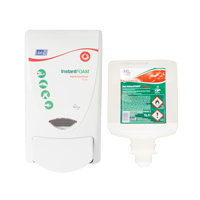
|
|
| Mini Hand Sanitisation Unit |
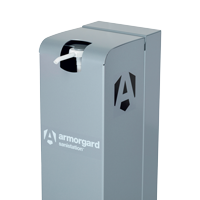
|
|
Where should hand sanitiser be stored?
Owing to the high alcohol content - usually ethyl alcohol - in the view of the authorities, these products are a flammable liquid. Therefore it is strongly recommended that even small quantities of alcohol-based hand sanitiser (ABHS) is stored in a place that is;
- Well ventilated
- Separated from work or living spaces, away from exits, electrical and heating equipment
- Away from any source(s) of ignition
If you need to decant a bulk container take extra care to ensure all containers are properly sealed to avoid leakage.
VENTILATED
Many alcohol-based hand sanitisers are classed as flammable products.
As such they should always be stored in well-ventilated spaces.
SEPARATED
ABHS products should be kept in a separate space from living or working areas, as well as exits and electrical or heating equipment.
IGNITION
All alcohol-based hand sanitisers must be kept clear of all sources of ignition.
If you are in any doubt about where to store your supply of hand sanitiser, it may be helpful to consult your risk assessment to identify a suitable location that meets the primary requirements.
For best practice, we strongly recommend installing compatible dispenser and cartridge refill systems, such as the DEB 7 Circles Cutan® Sanitise Dispenser. Don’t forget to add the compatible Deb Cutan Complete® Foam Hand Sanitiser to your order.
Where should hand sanitisers be used?
Every place of work will require specific placement for a hand sanitiser dispenser. After performing a full risk assessment, as per HSE guidelines, you will have a good sense of the best locations for hand sanitiser dispenser placement.
It is important that hand sanitisers are placed in visible, easy to access locations, so that employees, visitors and customers will be more likely to use the sanitiser.
| Type | Wall-Mounted | Hands-Free | Standalone |
|---|---|---|---|
| Image |
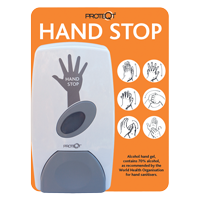
|
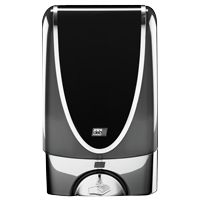
|
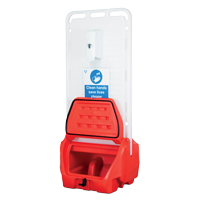
|
| Example Product | Alcohol Hand Sanitiser Station | DEB TouchFree Ultra Dispensers | Sanitisation S20 |
Below are some of the types of installation methods and placements that are offered in Seton’s expansive range of sanitisers.
Wall mounted hand wash dispenser
An effective and easy way to encourage proper hygiene in the workplace is through installing a wall mounted solution dispenser. Remind individuals of proper hand hygiene with the Alcohol Hand Sanitiser Station - a manual dispenser unit with a vibrant backplate providing instructions on correct washing procedure.
Hands free anti-viral hand gel dispenser
If you are looking for tools to drastically cut down on the possible transmission of bacteria and germs, electrical hands-free dispensers are a great option for the workplace. The Deb TouchFree Ultra Dispensers are both stylish and convenient as they can be installed on any hard surface and have long lasting batteries.
Standalone antiseptic hand gel dispenser
For some workplaces, it may be more convenient to use standalone dispenser sets. Seton offers a number of convenient standalone sanitisers, including the Mini Hand Sanitisation Unit or Sanitisation S20 portable unit.
No matter what format you need, you can be sure Seton has a solution for you. Our experts select only the best quality products and accessories to help you comply with legal obligations and safeguard your staff and visitors. Shop today for our best price as well as quick and fuss-free delivery on all orders.
